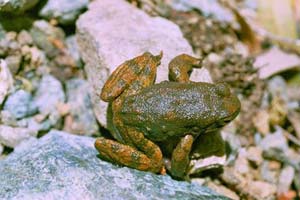|
 The skin of certain frogs, including this foothill yellow-legged frog, contains secretions that may lead to new antibiotics to fight infections that shrug off the effects of existing antibiotics. |
J. Michael Conlon is a biochemist at the United Arab Emirates University, he says frog skin, which protects the amphibians from injury and disease, is coming to the rescue by providing a wealth of new antibiotic compounds to fight drug resistant fungi and bacteria.
"Frogs of necessity have to live in a warm moist environment that is very conducive to the growth of micro-organisms. They've been around for a long, long time, at least 300 million years," says Conlon. "So, it's not so surprising that, over the course of evolution, they have developed defenses against these invading pathogens."
Conlon has identified germ-fighting chemicals from more than 200 frog species from around the world by isolating peptides or strings of proteins that have the ability to kill bacteria and fungi.
He says the challenge is to get those agents to work in humans. "The problem is that as well as efficiently killing micro-organisms, they are to various degrees toxic to mammalian cells. So it's not a great idea to cure infection if you kill the patient at the same time."
Fighting two major pathogens
Conlon's laboratory in the United Arab Emirates works with samples from frogs gathered collaboratively by scientists in Japan, France and the United States.
The naturally occurring compounds are first purified and then synthesized. At that point, structural changes are made in the molecules. The results have proved to be less toxic to human cells.
Conlon says the new compounds show promise in fighting two major pathogens, the well known methicillin-resistant Staphylococcus aureus (MRSA) and a new emerging bacterium, Acintobacter baumanni. "This has been called the Iraqibacter because many wounded soldiers in Iraq have developed infections by this microorganism."
Frog mouthwash
Conlon also sees great potential for other antibiotic applications from creams and ointments for wounds to treatment of footulcers. He adds that the peptides have shown to be very effective against oral pathogens. "So we are interested in the possibility of incorporating of incorporating them into a mouth wash."
But Conlon says as a researcher in a small laboratory, he can only take the product so far. "To bring a drug from the laboratory to the pharmacy costs literally hundreds of millions of dollars. We really need a partner in the pharmaceutical industry with which to collaborate."
Should that partner step forward, J. Michael Conlon predicts that some frog-skin derived compounds could make their way into clinical trials and into marketable drugs within five years.
amphibian: any animal that can live both on land and in water.Amphibians have cold blood and skin without scales.Frogs,toads and newts are all amphibians(两栖动物)
fungi: fungus的复数,真菌。
pathogen: a thing that causes disease(病原体)
peptide: 缩氨酸
ulcer: a sore area on the outside of the body or on the surface of an organ inside the body which is painful and may bleed or produce a poisonous substance(溃疡)
How autoimmune diseases attack the body's defenses
China issues guideline on use of antibiotics
(来源:VOA 编辑:陈丹妮)
